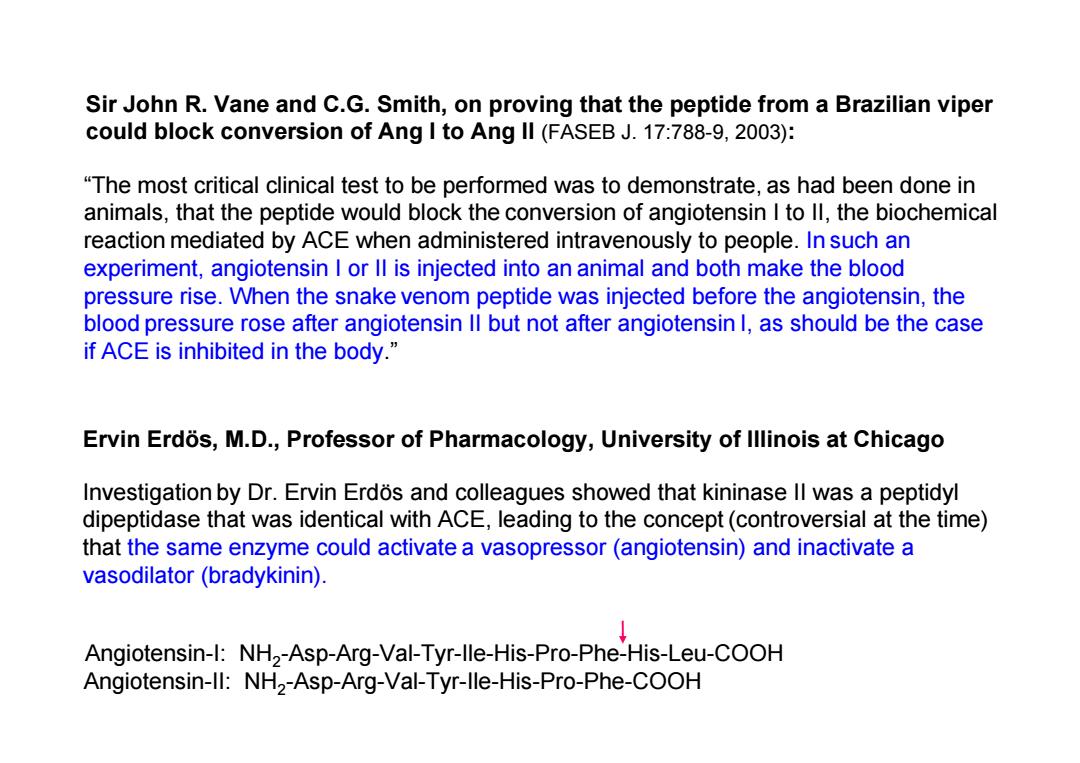正在加载图片...

Sir John R.Vane and C.G.Smith,on proving that the peptide from a Brazilian viper could block conversion of Ang I to Ang ll(FASEB J.17:788-9,2003): "The most critical clinical test to be performed was to demonstrate,as had been done in animals,that the peptide would block the conversion of angiotensin I to ll,the biochemical reaction mediated by ACE when administered intravenously to people.In such an experiment,angiotensin I or ll is injected into an animal and both make the blood pressure rise.When the snake venom peptide was injected before the angiotensin,the blood pressure rose after angiotensin ll but not after angiotensin 1,as should be the case if ACE is inhibited in the body.' Ervin Erdos,M.D.,Professor of Pharmacology,University of Illinois at Chicago Investigation by Dr.Ervin Erdos and colleagues showed that kininase ll was a peptidyl dipeptidase that was identical with ACE,leading to the concept(controversial at the time) that the same enzyme could activate a vasopressor(angiotensin)and inactivate a vasodilator(bradykinin). Angiotensin-I:NH2-Asp-Arg-Val-Tyr-lle-His-Pro-Phe-His-Leu-COOH Angiotensin-ll:NH2-Asp-Arg-Val-Tyr-lle-His-Pro-Phe-COOH“The most critical clinical test to be performed was to demonstrate, as had been done in animals, that the peptide would block the conversion of angiotensin I to II, the biochemical reaction mediated by ACE when administered intravenously to people. In such an experiment, angiotensin I or II is injected into an animal and both make the blood pressure rise. When the snake venom peptide was injected before the angiotensin, the blood pressure rose after angiotensin II but not after angiotensin I, as should be the case if ACE is inhibited in the body.” Sir John R. Vane and C.G. Smith, on proving that the peptide from a Brazilian viper could block conversion of Ang I to Ang II (FASEB J. 17:788-9, 2003): Investigation by Dr. Ervin Erdös and colleagues showed that kininase II was a peptidyl dipeptidase that was identical with ACE, leading to the concept (controversial at the time) that the same enzyme could activate a vasopressor (angiotensin) and inactivate a vasodilator (bradykinin). Ervin Erdös, M.D., Professor of Pharmacology, University of Illinois at Chicago Angiotensin-I: NH 2-Asp-Arg-Val-Tyr-Ile-His-Pro-Phe-His-Leu-COOH Angiotensin-II: NH 2-Asp-Arg-Val-Tyr-Ile-His-Pro-Phe-COOH